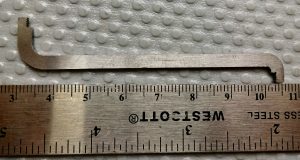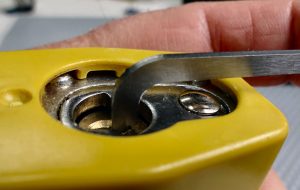All right, let’s up your game a bit! You’ve found a Master #17, Hercules 600 (also called a Herculock) or Wilson Bohannon, hopefully cheap on eBay. The Master #17 is almost identical to your #3 except it contains five standard pins instead of four. If you bought the #17 and the Hercules and WB, I’d recommend beginning with the #17 and move to the Hercules or WB once your skills have progressed. These two are not easy locks and you’ll discover they are in an entirely different class of locks.
Begin this lesson by attacking your #17 using the same techniques you used on your #3. Attempt to rake it open, zip it, and your W-rake kinetic attack. Attempt to rock it open using your L-Rake. You’ll find that it is slightly more difficult because statistics aren’t working in your favor with that extra pin. Just a single extra pin makes raking it to the shear line much less likely. SPPing will also take longer as you figure out the new binding order and take the time to pick that extra pin. Suddenly you’ll realize why mental mapping is important.
After a few days you’ll realize your “feel” of the pins has improved dramatically and you’re able to predict exactly when the #17 will pop open. Your tensioning will improve and you’ll find that you’re detecting feedback from the tension wrench as well as your pick. Now you’re “hearing” your lock in stereo!
Before you get TOO cocky, set aside that #17 and grab your Hercules or Wilson Bohannon. It won’t take too long before you discover the game has changed on you yet again. The WB is a completely different animal! It has the same number and type of pins as the #17, but the lock is much higher quality. To pick it you’ll need to further refine your light tension technique, REALLY pay attention to the pin’s feedback, and keep a good mental map as you’re working on it. Both the Hercules and WB are very good locks and considered difficult-to-pick standard pin locks. The WB company pride themselves on the fact that precision is the primary security measure in their locks and don’t feel security pins are necessary. By the time you’re competent picking your Hercules and WB, you’ll have become very proficient with standard pins.

Now it’s time to introduce another tensioning technique. At first you will hate it, because you’ve gotten used to using BOK tensioning. Give this new technique, called Top-of-the-Keyway (TOK), a chance. You will find it infinitely useful as you move on to more complex locks with weirdly shaped, paracentric, or heavily warded keyways. If you fail to learn TOK tensioning, conquering those more advanced locks will not be possible.
TOK requires a different tool, but you can also make your own from steak knives and windshield wiper inserts. Most beginner kits don’t come with TOK tensioners, but when I specced out the LockLab kit I insisted they include it. TOK is a necessary tool for beginners and advanced pickers alike, and the earlier in your training you learn to master it, the better off you will be.

The commercial TOK has two ends, a short and long end. The short end is for flush-faced locks where the extra reach isn’t needed. The long end is for recessed lock faces like those found on replaceable core padlocks and shielded locks. The extra length of the long end lets you reach down into the recessed keyway without dragging your tool on the lock body, rain cover, or rivets.
Practice using your TOK on the Master #17, Hercules and Wilson Bohannon. You’ll quickly see the advantages it gives you. It offers better control of the lock core, transfers vibrations better to your finger, and gives you more room to work in the bottom of the lock. Once you get the coordination part down, there are no down sides to using your TOK on ALL of your locks. Once I started using TOK tensioners, I rarely found a reason to pull out the old BOK tensioners.
If you don’t want to make a TOK tool, you can find inexpensive commercially made ones from Sparrows or Mad Bob’s.
Once you’ve mastered these locks using your TOK tensioner, there’s nothing more I can teach you about them, so let’s introduce your first security pin, the spool in LP202.